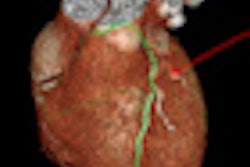A new analysis of coronary CT angiography (CCTA) demonstrates the need to obtain coronary calcium scores before scanning patients with suspected obstructive disease, while also underscoring the need for pretest calculation of disease probability, researchers report in the Journal of the American College of Cardiology.
Data from the international Coronary Artery Evaluation Using 64-Row Multidetector Computed Tomography Angiography (CORE 64) trial show that calcium scores and pretest likelihood of coronary artery disease are two essential predictors of CCTA's ability to exclude or confirm the presence of obstructive disease, wrote Dr. Armin Arbab-Zadeh, PhD, from Johns Hopkins University, and colleagues from several other centers.
CCTA definitively rules out obstructive disease in patients with low or intermediate pretest probability who also had low coronary artery calcium scores, they wrote. On the other hand, CTA is less effective in patients with a high pretest probability, known coronary artery disease, and extensive coronary calcification, since the presence of heavy calcification alone is predictive of obstructive coronary artery disease.
Previous studies have demonstrated high negative predictive values for CCTA. "However, predictive values heavily depend on disease prevalence within the study population; thus, they cannot be applied outside the context of a defined patient group," wrote Arbab-Zadeh and colleagues. "Because of the perceived limitation of CTA in patients with severe coronary calcification, many investigators have favored obtaining a coronary calcium score to inform the decision whether to proceed with CTA" (JACC, January 24, 2012, Vol. 59:4, pp. 379-387).
However, the use of a coronary calcium scoring threshold to determine the suitability of performing CCTA remains controversial. An accompanying editorial by Dr. Steven Nissen from the Cleveland Clinic argued that the results mean CCTA should be used sparingly pending the results of large studies that measure outcomes rather than merely the prevalence of coronary artery stenosis (pp. 388-389).
Impact on accuracy
The study sought to assess the impact of patient population characteristics on accuracy by CTA to detect obstructive coronary artery disease (CAD). The analysis was based on data from the CORE 64 trial, a prospective, multicenter study performed at nine hospitals in seven countries. It was designed to evaluate CCTA's diagnostic accuracy in patients with suspected or known significant disease.
The CORE 64 investigators evaluated 371 patients using both CCTA and cardiac catheterization for detecting obstructive CAD, defined as 50% or greater luminal stenosis by quantitative coronary angiography.
The new analysis includes 80 patients with a calcium score of at least 600 who had been excluded from analysis in the original study. Area under the receiver operator characteristics (AUC) curve was used to evaluate CCTA's diagnostic accuracy compared to quantitative coronary angiography in patients based on calcium score and pretest probability of CAD.
"The rationale by the steering committee for excluding patients with calcium score ≥ 600 was based on: 1) the precedence of excluding such patients in a prior multicenter study; and 2) the concern of futility of CTA imaging in such patients based on the data available at the study design planning," the authors wrote.
The 371 eligible patients had no contraindications to CCTA or iodinated contrast, were at least 40 years of age (average, 61 ± 10 years; 75% male), had suspected symptomatic CAD, and were referred for conventional coronary angiography.
Each underwent two CT scans (coronary calcium scoring and CCTA ) using 64-detector-row scanners with a slice thickness of 0.5 mm (Aquilion 64, Toshiba America Medical Systems) within 30 days of undergoing conventional coronary angiography.
Pitch and tube currents were adjusted by patient weight for a maximum radiation dose of 20 mSv for both CCTA and calcium scoring. Calcium scoring was performed with the use of prospective electrocardiogram gating, 120-kV tube voltage, and 300-mA tube current. CTA was performed using retrospective electrocardiogram gating, the authors wrote.
Analysis of patient-based CCTA's accuracy showed an AUC of 0.93 (95% confidence interval [CI]: 0.90-0.95). The AUC remained at 0.93 (95% CI: 0.90-0.96) after excluding patients with known coronary artery disease, but dropped to 0.81 (95% CI: 0.71-0.89) in patients with a calcium score of 600 or greater (p = 0.077).
While AUCs were similar (0.93, 0.92, and 0.93, respectively) for patients with intermediate pretest probability for CAD, high pretest probability, and known CAD, the negative predictive values were different: 0.90 (intermediate), 0.83 (high probability), and 0.50 (known coronary artery disease). The AUC did not change for the remaining 273 patients after excluding those with known coronary artery disease, the authors wrote.
Low calcium scores
Only 53 (35%) of 151 patients with calcium scores of 100 or less had obstructive disease by conventional angiography, while 181 (82%) of 220 patients with calcium scores of 100 or greater had significant disease, Arbab-Zadeh and colleagues reported.
For patients with calcium scores less than 100 and intermediate pretest probability, disease prevalence was only 25%, compared with 55% in patients with high pretest probability or known coronary artery disease. In those with calcium scores greater than 100, disease prevalence was similarly high for patients with intermediate (77%) and high (85%) pretest probability of known CAD.
Negative predictive values were poor (50% to 64%) for patients with high pretest probability or known CAD and any coronary calcification, the authors wrote. Among patients with an intermediate pretest probability of disease, positive predictive values were modest (60% to 80%) and negative predictive values were excellent (91% to 96%) only when calcium scores were less than 100, while positive predictive values were very good (90% to 93%) and negative predictive values were poor (71% to 78%) with moderate and severe coronary calcification.
"Despite poorer performance in patients with severe coronary calcification, inclusion of such patients did not alter the overall test performance of CTA to detect a ≥ 50% stenosis," the authors wrote.
CCTA's diagnostic accuracy for detecting obstructive disease was reduced in patients with calcium scores greater than 600. In addition, the pretest probability of coronary artery disease and coronary calcium score "markedly affect negative predictive values" for detecting coronary artery disease using CCTA.
Best results
CCTA is best at ruling out obstructive coronary artery disease in patients with low to intermediate pretest probability of CAD and mild coronary calcification or zero calcium, the authors wrote.
"In our study, we demonstrate that predictive values critically depend on the disease prevalence in the study population," they wrote. "With rising disease prevalence, positive predictive values increase while negative predictive values decrease. Thus, general statements regarding the positive or negative predictive value of CTAs or any other tests should be avoided, as even a test with high sensitivity and specificity displays a remarkable variability for predictive values within a clinically applicable range of disease prevalence."
The predictive value of a diagnostic test, considered in the context of the study population, should be applied accordingly. "Both pretest probability and calcium score identify patients of different disease prevalence and may help [in] recognizing the most adequate clinical scenario for the use of CTA," the group wrote.
The results also showed a reduced accuracy of CCTA for detecting obstructive CAD in patients with severe coronary calcification that was mostly "the result of markedly poorer specificity while sensitivity actually improved," they wrote. "Therefore, CTA is ineffective for ruling out coronary arterial stenoses in patients with severe coronary calcification who were referred for invasive angiography because of clinical suspicion of significant CAD."
In patients with a clinical suspicion of coronary artery disease high enough to consider cardiac catheterization, moderate or severe coronary calcification alone is highly predictive of obstructive disease, the group concluded.
Not proof enough
In his accompanying editorial, Nissen noted several hurdles CCTA still has to jump for detecting coronary artery disease. For one thing, the presence or absence of a 50% stenosis "does not define whether revascularization is appropriate or inappropriate," he wrote. "Symptoms and the presence of reversible ischemia are the pivotal factors determining the appropriateness of coronary interventions."
In addition, the use of radiation with CCTA must be justified, although the doses are falling in sophisticated centers using newer scanning techniques.
"To justify widespread usage, the technique must be shown to improve relevant patient outcomes, including survival, improve the accuracy of diagnoses, or substantially reduce healthcare costs," he wrote. "None of these benefits has yet been demonstrated convincingly for coronary CTA."
Yet the present study "helps us understand what must be expected in subsequent studies examining the clinical utility of CTA," he wrote. Future studies must evaluate clinical outcomes, not just stenoses, in a wide spectrum of patients.
"Pending such evaluation, coronary imaging using CTA should be used sparingly, with full recognition of the radiation burdens and risks of misdiagnosis," Nissen wrote.



















